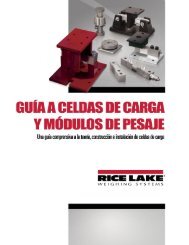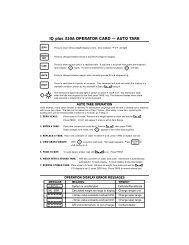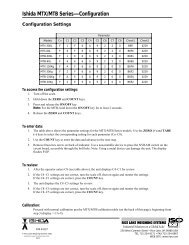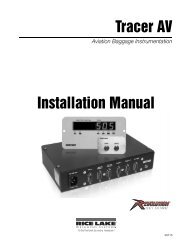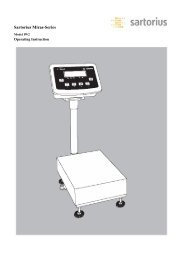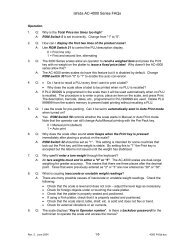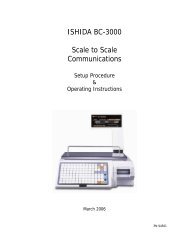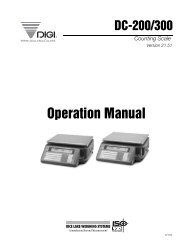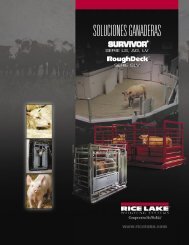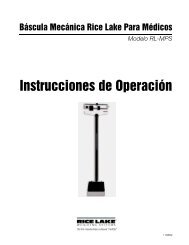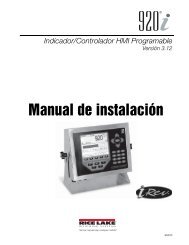Installation Manual - Rice Lake Weighing Systems
Installation Manual - Rice Lake Weighing Systems
Installation Manual - Rice Lake Weighing Systems
You also want an ePaper? Increase the reach of your titles
YUMPU automatically turns print PDFs into web optimized ePapers that Google loves.
Summit 3000<br />
Low-Profile Floor Scale<br />
<strong>Installation</strong> <strong>Manual</strong><br />
76012
Contents<br />
1.0 Introduction and System Overview.............................................................................................. 1<br />
1.1 Operating Requirements. . . . . . . . . . . . . . . . . . . . . . . . . . . . . . . . . . . . . . . . . . . . . . . . . . . . . . . . . . . 1<br />
2.0 <strong>Installation</strong> ................................................................................................................................... 2<br />
2.1 Overview . . . . . . . . . . . . . . . . . . . . . . . . . . . . . . . . . . . . . . . . . . . . . . . . . . . . . . . . . . . . . . . . . . . . . . 2<br />
2.2 Site Preparation . . . . . . . . . . . . . . . . . . . . . . . . . . . . . . . . . . . . . . . . . . . . . . . . . . . . . . . . . . . . . . . . . 2<br />
2.3 Unpacking . . . . . . . . . . . . . . . . . . . . . . . . . . . . . . . . . . . . . . . . . . . . . . . . . . . . . . . . . . . . . . . . . . . . . 2<br />
2.4 Assembly . . . . . . . . . . . . . . . . . . . . . . . . . . . . . . . . . . . . . . . . . . . . . . . . . . . . . . . . . . . . . . . . . . . . . . 3<br />
2.4.1 Installing and adjusting feet . . . . . . . . . . . . . . . . . . . . . . . . . . . . . . . . . . . . . . . . . . . . . . . . . . . . . . . . . . 3<br />
2.4.2 Anchor Plate <strong>Installation</strong> . . . . . . . . . . . . . . . . . . . . . . . . . . . . . . . . . . . . . . . . . . . . . . . . . . . . . . . . . . . . 3<br />
2.5 Electrical Interface to Indicator . . . . . . . . . . . . . . . . . . . . . . . . . . . . . . . . . . . . . . . . . . . . . . . . . . . . . . 4<br />
2.6 Pit <strong>Installation</strong> . . . . . . . . . . . . . . . . . . . . . . . . . . . . . . . . . . . . . . . . . . . . . . . . . . . . . . . . . . . . . . . . . . . 5<br />
2.7 Access Ramps . . . . . . . . . . . . . . . . . . . . . . . . . . . . . . . . . . . . . . . . . . . . . . . . . . . . . . . . . . . . . . . . . . 6<br />
3.0 Adjustments and Calibration ....................................................................................................... 7<br />
3.1 Mechanical Adjustments. . . . . . . . . . . . . . . . . . . . . . . . . . . . . . . . . . . . . . . . . . . . . . . . . . . . . . . . . . . 7<br />
3.2 Corner Correction. . . . . . . . . . . . . . . . . . . . . . . . . . . . . . . . . . . . . . . . . . . . . . . . . . . . . . . . . . . . . . . . 7<br />
3.3 Calibration Procedure. . . . . . . . . . . . . . . . . . . . . . . . . . . . . . . . . . . . . . . . . . . . . . . . . . . . . . . . . . . . . 8<br />
4.0 Service Information ..................................................................................................................... 9<br />
4.1 Troubleshooting Guide . . . . . . . . . . . . . . . . . . . . . . . . . . . . . . . . . . . . . . . . . . . . . . . . . . . . . . . . . . . . 9<br />
4.2 Periodic Maintenance . . . . . . . . . . . . . . . . . . . . . . . . . . . . . . . . . . . . . . . . . . . . . . . . . . . . . . . . . . . . . 9<br />
4.3 Load Cell Replacement . . . . . . . . . . . . . . . . . . . . . . . . . . . . . . . . . . . . . . . . . . . . . . . . . . . . . . . . . . 10<br />
4.3.1 Load Cell Wiring to Junction Box. . . . . . . . . . . . . . . . . . . . . . . . . . . . . . . . . . . . . . . . . . . . . . . . . . . . . 11<br />
Summit 3000 Limited Warranty............................................................................................................. 12<br />
Technical training seminars are available through <strong>Rice</strong> <strong>Lake</strong> <strong>Weighing</strong> <strong>Systems</strong>.<br />
Course descriptions and dates can be viewed at www.ricelake.com or obtained<br />
by calling 715-234-9171 and asking for the training department<br />
© 2007 <strong>Rice</strong> <strong>Lake</strong> <strong>Weighing</strong> <strong>Systems</strong>. All rights reserved. Printed in the United States of America.<br />
Specifications subject to change without notice.<br />
January 2007<br />
i
ii<br />
Summit 3000 <strong>Installation</strong> <strong>Manual</strong>
•<br />
O N<br />
•<br />
1.0 Introduction and System Overview<br />
The Summit 3000 floor scale provides exceptional performance and serves as an economical solution in light<br />
industrial applications.<br />
The Summit 3000 floor scale is a fully electronic, low profile floor scale that comes in sizes from 36 in x 36 in<br />
(.91 m x .91 m) to 60 in x 60 in (1.52 m x 1.52 m), and capacities from 2K- to 10K-lbs (1000–5000 kg). All<br />
models use four corner-mounted, NTEP-certified, alloy steel shear beam load cells, with the cells recessed into<br />
the frame channels for protection. Also included signal-trim summing board enclosed in a durable ABS<br />
enclosure that has a convenient top-access for any necessary corner corrections. All models come pre-trimmed so<br />
corner corrections should not be necessary.<br />
Load cell cables are run through the main channels, and held down with replaceable cable ties near each corner,<br />
eliminating the possibility of cable damage in portable applications. One threaded hole, located in the center of<br />
the deck, is another useful feature for portable applications. This allows for placement of a removable eyebolt to<br />
lift the scale from above with chains. Because of the possibility of foot and load cell damage from forklift tines,<br />
the scale should always be lifted from above with chains through the eyebolt.<br />
The adjustable feet are used to allow leveling the scale to make up for minor floor irregularities. For permanent<br />
installations, two of the four feet can be held in place on the floor with optional floor anchor plates to guard<br />
against deck movement.<br />
Other available options include custom frames for pit installations and access ramps for all sizes of the Summit<br />
3000. Decks designed for use in pits can be ordered with holes drilled in the deck directly above each foot for<br />
adjusting foot height with a screwdriver from above.<br />
Figure 1-1. The Summit 3000 Floor Scale<br />
Authorized distributors and their employees can view or download this manual from the <strong>Rice</strong> <strong>Lake</strong> <strong>Weighing</strong> <strong>Systems</strong><br />
distributor site at www.ricelake.com.<br />
1.1 Operating Requirements<br />
Electrical Grounding<br />
For systems where the scale is connected to a 115<br />
VAC circuit, the indicator must be directly connected<br />
to an earth ground with a ground interface cable of no<br />
more than 3W resistance throughout its length.<br />
Load Cell Excitation<br />
Rated Excitation: 10 VDC<br />
Maximum Excitation: 15 VDC<br />
Grade Level Requirements<br />
The supporting surface for the four feet of the scale<br />
must be level within 1/4 inch of horizontal.<br />
Safe Static Overloading Capacity<br />
Maximum: 150% of scale capacity<br />
Nominal Scale Height<br />
3.625 inch (92 mm)<br />
Approvals<br />
NAT<br />
W E<br />
I ON AL<br />
I G H T S<br />
CONF E R ENCE<br />
A N D<br />
M E A S U R E S<br />
NTEP CoC Number 03-014<br />
Introduction and System Overview 1
2.0 <strong>Installation</strong><br />
The following sections describe the correct installation procedures when installing the Summit 3000 floor scale.<br />
2.1 Overview<br />
Standard installation of the Summit 3000 floor scale consists of the following steps:<br />
1. Select a site<br />
2. Check levelness and smoothness of site<br />
3. Unpack the floor scale<br />
4. Adjust the four feet on the scale<br />
5. Install mounting plates to the floor (optional)<br />
6. Connect cable to the indicator<br />
7. Calibrate the unit<br />
Pit installations and access ramps are described in Section 2.6 and Section 2.7 on page 5 and page 6, respectively.<br />
2.2 Site Preparation<br />
The scale must not be loaded beyond its capacity, even momentarily. Avoid areas where the scale might receive<br />
damaging side impacts from wheels or forklift tines, or shock damage from falling objects. Avoid areas where<br />
water may damage a scale not meant for a washdown environment.<br />
The interface cable between the scale and the indicator must be protected against crushing, cutting, or moisture<br />
damage. If the chosen site has such potential dangers, some method of protection, such as running the cable in<br />
conduit, is necessary.<br />
In operation, the scale must be level within 1/4". Either choose a site where the floor is close to this standard to<br />
avoid excessive shimming, or modify the floor at the chosen site to meet this standard.<br />
2.3 Unpacking<br />
Remove all packing material and visually inspect the floor scale for visible damage caused during shipment. The<br />
shipping container should contain the floor scale, floor scale feet, this manual, and a 20-ft length of load cell<br />
cable.<br />
All Summit 3000 models have one threaded eyebolt hole located in the center of the deck to allow installation of<br />
an eyebolt hook for use when lifting the scale with chains.<br />
It’s recommended to use a 1/2 in-13NC eyebolt in 2K–10K-lb capacity scales.<br />
Figure 2-1. Proper Lifting Technique<br />
2 Summit 3000 <strong>Installation</strong> <strong>Manual</strong>
2.4 Assembly<br />
The following paragraphs give instructions for installing and adjusting the scale feet and anchor plate.<br />
2.4.1 Installing and adjusting feet<br />
For load cell protection during shipping, the scale feet<br />
are shipped separately from the floor scale.<br />
Screw one foot into each load cell and turn all the way<br />
in until the foot touches either the load cell or the<br />
underside of the deck. Then unscrew each foot three<br />
complete turns.<br />
Place a spirit level on the deck. Adjust any “high”<br />
corners not in contact with the floor by further<br />
unscrewing the feet on those corners until they just<br />
contact the floor surface. When all feet are in contact<br />
with the floor, check the deck with the spirit level to<br />
be sure the scale is within 1/4 inch of level.<br />
2.4.2 Anchor Plate <strong>Installation</strong><br />
For permanent applications, the scale should be<br />
secured to the floor to prevent sideways movement.<br />
Two mild steel, floor anchor plates, with holes that<br />
slightly exceed the foot diameter, are available as an<br />
option for that purpose.<br />
Lift the scale so that the feet are approximately one<br />
inch off the floor. Slide mounting plates under two<br />
diagonally opposed feet. Lower the scale back to the<br />
floor, and position the plates as shown in Figure 2-2 so<br />
that the boltdown holes are accessible from above.<br />
Using the mounting plates as templates, drill pilot<br />
holes into the floor for suitable anchor bolts. Bolt the<br />
plates to the floor using 1/2-in anchor bolts. Recheck<br />
foot adjustment and deck level after this operation.<br />
Note: For installations using access ramps, mounting plates<br />
are not necessary as the ramps have built-in mounting plates<br />
to secure the scale feet.<br />
SCALE DECK<br />
.56" DIA (2K–10K models)<br />
3.50"<br />
ANCHOR PLATE<br />
FOOT<br />
Figure 2-2. Anchor Plate <strong>Installation</strong><br />
<strong>Installation</strong> 3
2.5 Electrical Interface to Indicator<br />
Twenty feet of 6-wire cable to connect the scale to the weight indicator is supplied with each scale. The junction<br />
box is easily accessible through a top access plate located on the top of the Summit 3000. Use the following steps<br />
to wire up the junction box.<br />
1. Remove the four screws using an allen wrench.<br />
2. Slide the junction box assembly out of the deck.<br />
3. Open and remove the top of junction box.<br />
4. Push the cable end into the junction box through a cord grip.<br />
5. Connect the wires to the indicator terminal (Figure 2-3) as shown in Table 2-1.<br />
6. Pull out excess and tighten the cord grip to hold the cable snugly.<br />
Cable Color Code<br />
Red<br />
Black<br />
Green<br />
White<br />
Bare<br />
Yellow<br />
Blue<br />
Junction Box<br />
+ Excitation<br />
- Excitation<br />
+ Signal<br />
- Signal<br />
Shield<br />
+ Sense<br />
- Sense<br />
Table 2-1. Junction Box Connections<br />
Indicator<br />
Terminal<br />
Location<br />
Figure 2-3. Junction Box Wiring Diagram<br />
7. The cable must be routed to the indicator in a manner that will protect the cable from damage. This<br />
method of cable protection in non-washdown applications are shown in Figure 2-4. When planning cable<br />
routing, leave a loose coil of excess cable under the scale to facilitate future lifting of the scale for<br />
servicing or cleaning.<br />
LOAD CELL CABLE<br />
STEEL COVER<br />
FLOOR<br />
Figure 2-4. Load Cell Protection<br />
4 Summit 3000 <strong>Installation</strong> <strong>Manual</strong>
8. When the interface cable is protected and in its final position, complete connections to the indicator. See<br />
the indicator installation manual for wiring information.<br />
9. If necessary, trim corners as described in Section 3.2.<br />
10. Check all strain relief fittings for tightness.<br />
11. Put the cover back onto the junction box assembly and place the junction box back into the floor scale<br />
cutout.<br />
12. Secure the Summit 3000 floor plate.<br />
2.6 Pit <strong>Installation</strong><br />
The Summit 3000 can be installed in a shallow pit using the optional Summit 3000 pit frame. Optional<br />
height-adjustment holes are available. The following site considerations and pit frame drawings are meant only<br />
as a brief overview of the principles involved with mounting the scale in a floor-level pit. The pit must be<br />
installed in a suitable poured-concrete foundation according to standard construction practices.<br />
COVER PLATE<br />
Figure 2-5. Pit Frame Diagram<br />
Site Considerations<br />
Debris, floor sweepings, or material spills may accumulate in the pit and interfere with scale operation. You<br />
should periodically clean the pit. All sizes of the Summit 3000 have a threaded hole centrally located for eyebolts<br />
so the scale can be easily lifted from the pit.<br />
Weight overloads, even momentary ones such as driving a loaded forklift over a scale corner, will damage load<br />
cells. Plan the pit location out of main traffic areas to prevent such accidental damaging overloads.<br />
<strong>Installation</strong> 5
A 1:24 slope is recommended for the pit, with full grouting under the corner pads as shown in Figure 2-6.<br />
LOAD CELL<br />
FOOT ASSEMBLY<br />
CUP<br />
GROUT<br />
1:24 SLOPE<br />
Figure 2-6. Section Showing Installed Summit 3000 and Pit Frame<br />
2.7 Access Ramps<br />
Access ramps for Summit 3000 floor scales are designed to bolt to the floor, with built-in mounting plates that<br />
attach to the scale feet. When used with access ramps, side movement of the scale is automatically eliminated,<br />
and no other mounting plates are necessary.<br />
Access ramps can only be attached to the scale on one of the two scale sides that are perpendicular to the<br />
longitudinal axis of the load cells. For example, the scale shown in Figure 2-7 could have an access ramp on the<br />
left side as shown, and/or on the right side. The top and bottom sides, however, will not accept the ramp<br />
mounting plates.<br />
Longitudinal axis<br />
of load cells<br />
Figure 2-7. Optional Access Ramp<br />
6 Summit 3000 <strong>Installation</strong> <strong>Manual</strong>
3.0 Adjustments and Calibration<br />
The following sections describe adjustments that need to be made to the Summit 3000 floor scale.<br />
3.1 Mechanical Adjustments<br />
To accommodate minor floor unevenness, the scale feet can be used to adjust scale height up or down a fraction<br />
of an inch. Adjust the feet by hand (lift the scale corner slightly with a pry bar) until all feet are contacting the<br />
floor equally. No jam nuts are supplied for locking the feet, as there is a slight decrease in accuracy when jam<br />
nuts are tightened. However, if you feel that your application requires you to secure the feet, we suggest using<br />
Teflon ® tape or Loctite ® .<br />
When adjusting scale feet, use care to prevent the scale foot from bottoming out against the underside of the load<br />
cell. Also, the foot stem can be damaged by bending or stripping threads if extended beyond the maximum height<br />
adjustment.<br />
When height adjustments are complete, recheck level of the deck with a spirit level. The deck must be level<br />
within 1/4".<br />
3.2 Corner Correction<br />
All assembled Summit 3000 scales are delivered with the junction box corner-trimmed. Corner trimming is only<br />
necessary after replacing a load cell.<br />
To calibrate the scale, the output from each load cell must be matched by adjusting the signals with<br />
potentiometers at the junction box—a process known as trimming.<br />
Remove the junction box cover and identify the correct load cell terminal corresponding to each corner (labeled<br />
CELL 1, CELL 2, and so on). See Figure 4-4 on page 11 for scale deck corner numbering.<br />
The indicator must be connected and calibrated approximately, but it need not indicate the exact weight value. A<br />
test weight is required. The recommended test weight for all Summit 3000 models is 25% of scale capacity: for<br />
example, 500 lbs for 2K-lb models, 2500 lbs for 10K-lb models.<br />
With no weight on the scale, zero the indicator. Then turn all four potentiometers (Figure 3-1) clockwise to<br />
increase the reading until a clicking sound is heard from each potentiometer. This ensures the maximum signal<br />
from each load cell.<br />
Potentiometers<br />
Figure 3-1. Summing Board Diagram<br />
Teflon ® and Loctite ® are both registered trademarks of E.I. DuPont.<br />
Adjustments and Calibration 7
With all potentiometers at full signal, place the test weight over one corner and record the indicated weight.<br />
Repeat the process for each of the other three corners. The load cell with the lowest corner reading is used as a<br />
reference point and will not be trimmed.<br />
Next, place the test weight over one of the other three corners and use that cell’s potentiometer to adjust the cell<br />
output down to the reference cell output. Repeat this procedure with the other two high corners.<br />
Adjustments are somewhat interactive, and adjusting the three higher outputs may affect the reference cell<br />
output, especially in smaller scale decks. Rezero the indicator and repeat the test until all corners read within<br />
±.1% of the test weight used.<br />
3.3 Calibration Procedure<br />
Refer to the indicator manual to determine correct calibration procedures.<br />
It is recommended that the scale be “exercised” before calibration to be certain that everything is seated. Load<br />
the scale to near capacity two or three times.<br />
Then, with no load on the scale, place the indicator in its calibration mode and perform a zero calibration. Now<br />
place test weights on the platform equal to 70% - 80% of the scale’s capacity. If several weights are used, they<br />
should be evenly distributed around the platform. Perform a span calibration.<br />
Remove the test weights and check the zero reading. Repeat the calibration process if necessary.<br />
8 Summit 3000 <strong>Installation</strong> <strong>Manual</strong>
4.0 Service Information<br />
The following sections describe basic service and maintenance procedures.<br />
4.1 Troubleshooting Guide<br />
The following table lists some of the common problems and their suggested solutions.<br />
Problem Symptom Description Solution<br />
System does not Power disconnected<br />
Check and reconnect<br />
operate - no display<br />
Indicator fuse blown<br />
Replace the fuse. Check for cause<br />
Interface cable cut or disconnected Repair<br />
Signal leads incorrectly installed at the<br />
indicator<br />
Install according to indicator installation<br />
manual<br />
Display stays at zero Indicator faulty Service indicator<br />
Load cell connections faulty<br />
Check cable connections in junction box and<br />
at indicator<br />
Erratic weight Vibration near scale<br />
Remove source of vibration or move scale<br />
readings<br />
Platform not level to within 1/4 in. Level scale by adjusting feet or shimming if<br />
necessary<br />
Load cell or cable water damage Replace<br />
Debris under load cells or platform Clean<br />
Indicator faulty<br />
Use simulator to test indicator for stability.<br />
Service indicator<br />
Consistently high or<br />
low weights<br />
Indicator not properly adjusted to zero Zero the indicator according to the indicator<br />
manual<br />
Platform binding<br />
Obtain adequate clearance for free platform<br />
movement<br />
Indicator not calibrated<br />
Calibrate according to indicator manual and<br />
Section 3.3 on page 8<br />
Load cells faulty<br />
Test and replace load cells if necessary<br />
Feet touching deck underside<br />
Adjust feet downward to provide clearance<br />
Table 4-1. Troubleshooting Table<br />
4.2 Periodic Maintenance<br />
The space between the platform side and pit frame, and the surface beneath the platform must be periodically<br />
cleaned to prevent debris build up. More frequent cleaning of these areas is necessary with scales mounted in<br />
pits.<br />
Do not attempt to use scales with load cells that are not hermetically sealed in washdown applications. Water<br />
damage is a common cause of failure in non-hermetically-sealed load cells. Use care with high pressure steam<br />
washdowns for hermetically-sealed load cells. The steam may not damage the load cells, but the elevated<br />
temperatures may cause incorrect readings until the unit cools to room temperature.<br />
Service Information 9
4.3 Load Cell Replacement<br />
Replacement load cells can be ordered from <strong>Rice</strong> <strong>Lake</strong> <strong>Weighing</strong> <strong>Systems</strong> according to the part numbers listed<br />
below.<br />
<strong>Rice</strong> <strong>Lake</strong> PN Summit Model # Load Rating<br />
30106 2K models 1000 lb (453.6 kg)<br />
30112 5K models 2500 lb (1134.0 kg)<br />
30270 10K models 4000 lb (1814.4 kg)<br />
Table 4-2. Load Cell Replacement Numbers<br />
Lift the scale with a chain and remove foot, then remove the defective load cell. Disconnect load cell cable from<br />
the junction box and cut cable ties. When the cable is freed, pull cable out of the scale frame channels.<br />
Figure 4-1. Load Cell Assembly<br />
Follow the directions given below to install new load cells.<br />
Lay out the four load cells near the corners where they are to be installed. Thread the cable from each load cell<br />
through the conduit tubing in the frame and into the junction box according to the wiring diagram in Figure 4-2.<br />
Note that in Figure 4-2 both the scale and the junction box are viewed from the bottom. To verify correct load<br />
cell/junction box terminal matching, see the numbers on the terminals inside the junction box and the corner<br />
numbering diagram in Figure 4-4 on page 11.<br />
CELL 1 CELL 4<br />
CELL 2 CELL 3<br />
Figure 4-2. Bottom View of Scale<br />
10 Summit 3000 <strong>Installation</strong> <strong>Manual</strong>
Check that the threaded holes for the load cell screws<br />
are free of debris. Use compressed air to blow out<br />
holes if necessary. Position load cells with alignment<br />
arrows pointed up toward the deck and loosely install<br />
the hex head cap screws provided, as shown in<br />
Figure 4-1. If the base is used with a pit frame or<br />
access ramp, position the load cell to maintain the<br />
dimension shown in Figure 4-3. With the torque<br />
wrench, tighten all bolts to 75 ft-lbs.<br />
4.3.1 Load Cell Wiring to Junction Box<br />
The four load cells are each wired to their respective<br />
terminals in the junction box according to the corner<br />
numbering system shown in Figure 4-4, and the<br />
coloring code in Table 4-3.<br />
Pull excess cable out of the junction box enclosure<br />
and tighten the cable grips with a wrench. To be<br />
watertight, the cable grips must be tightened to the<br />
point where the rubber sleeving begins to protrude out<br />
of the hub. Finally, pull on each of the four cables to<br />
make sure that they do not slip.<br />
1<br />
2<br />
2K – 10K models: 1.625"<br />
Figure 4-3. Foot Pad - Side View<br />
Route the load cell cables near each corner so that the<br />
cable is free from possible contact with each foot.<br />
Hold the cable in position with the supplied<br />
adhesive-backed cable ties.<br />
Do not cut load cell cables. Coil extra cable before it<br />
enters the junction box, tie with cable ties, and insert<br />
the coils into the channel near the junction box.<br />
After coiling excess cable, pass each individual end of<br />
load cell cable through its grommet in the junction<br />
box cover (or through cable fittings in the NEMA 4X<br />
junction box).<br />
Corner correction trimming and calibration is<br />
necessary after load cell replacement. Follow<br />
instruction in Sections 3.2 and 3.3.<br />
4<br />
Figure 4-4. Corner Numbering - Top View<br />
Cable Color Code J-Box Terminal<br />
Red<br />
+Excitation<br />
Black<br />
-Excitation<br />
Green<br />
+Signal<br />
White<br />
-Signal<br />
Bare or Clear Shield<br />
Table 4-3. Load Cell Wiring<br />
3<br />
Service Information 11
Summit 3000 Limited Warranty<br />
<strong>Rice</strong> <strong>Lake</strong> <strong>Weighing</strong> <strong>Systems</strong> (RLWS) warrants that all RLWS equipment and systems properly installed by a<br />
Distributor or Original Equipment Manufacturer (OEM) will operate per written specifications as confirmed by<br />
the Distributor/OEM and accepted by RLWS. All systems and components are warranted against defects in<br />
materials and workmanship for two years.<br />
RLWS warrants that the equipment sold hereunder will conform to the current written specifications authorized<br />
by RLWS. RLWS warrants the equipment against faulty workmanship and defective materials. If any equipment<br />
fails to conform to these warranties, RLWS will, at its option, repair or replace such goods returned within the<br />
warranty period subject to the following conditions:<br />
• Upon discovery by Buyer of such nonconformity, RLWS will be given prompt written notice with a<br />
detailed explanation of the alleged deficiencies.<br />
• Individual electronic components returned to RLWS for warranty purposes must be packaged to<br />
prevent electrostatic discharge (ESD) damage in shipment. Packaging requirements are listed in a<br />
publication, Protecting Your Components From Static Damage in Shipment, available from RLWS<br />
Equipment Return Department.<br />
• Examination of such equipment by RLWS confirms that the nonconformity actually exists, and was<br />
not caused by accident, misuse, neglect, alteration, improper installation, improper repair or<br />
improper testing; RLWS shall be the sole judge of all alleged non-conformities.<br />
• Such equipment has not been modified, altered, or changed by any person other than RLWS or its<br />
duly authorized repair agents.<br />
• RLWS will have a reasonable time to repair or replace the defective equipment. Buyer is responsible<br />
for shipping charges both ways.<br />
• In no event will RLWS be responsible for travel time or on-location repairs, including assembly or<br />
disassembly of equipment, nor will RLWS be liable for the cost of any repairs made by others.<br />
THESE WARRANTIES EXCLUDE ALL OTHER WARRANTIES, EXPRESSED OR IMPLIED, INCLUDING WITHOUT<br />
LIMITATION WARRANTIES OF MERCHANTABILITY OR FITNESS FOR A PARTICULAR PURPOSE. NEITHER<br />
RLWS NOR DISTRIBUTOR WILL, IN ANY EVENT, BE LIABLE FOR INCIDENTAL OR CONSEQUENTIAL DAMAGES.<br />
RLWS AND BUYER AGREE THAT RLWS’S SOLE AND EXCLUSIVE LIABILITY HEREUNDER IS LIMITED TO<br />
REPAIR OR REPLACEMENT OF SUCH GOODS. IN ACCEPTING THIS WARRANTY, THE BUYER WAIVES ANY AND<br />
ALL OTHER CLAIMS TO WARRANTY.<br />
SHOULD THE SELLER BE OTHER THAN RLWS, THE BUYER AGREES TO LOOK ONLY TO THE SELLER FOR<br />
WARRANTY CLAIMS.<br />
NO TERMS, CONDITIONS, UNDERSTANDING, OR AGREEMENTS PURPORTING TO MODIFY THE TERMS OF THIS<br />
WARRANTY SHALL HAVE ANY LEGAL EFFECT UNLESS MADE IN WRITING AND SIGNED BY A CORPORATE<br />
OFFICER OF RLWS AND THE BUYER.<br />
© 2007 <strong>Rice</strong> <strong>Lake</strong> <strong>Weighing</strong> <strong>Systems</strong>, Inc. <strong>Rice</strong> <strong>Lake</strong>, WI USA. All Rights Reserved.<br />
12 Summit 3000 <strong>Installation</strong> <strong>Manual</strong>



